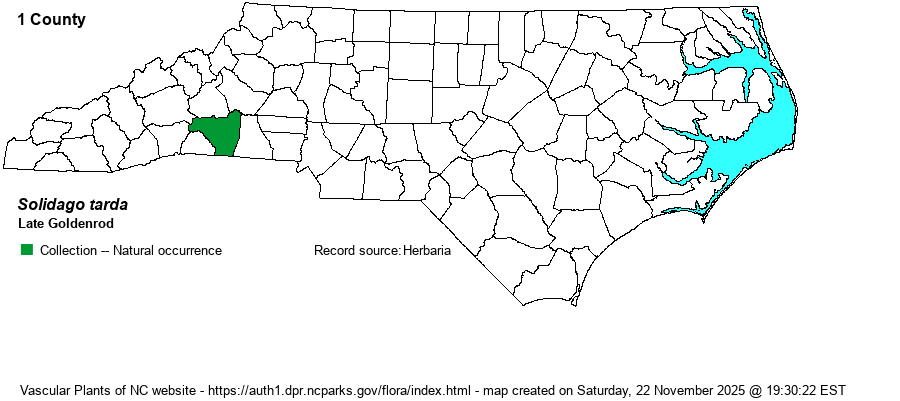| Author | Mackenzie | |
| Distribution | Solidago tarda is a split from the widespread and variable S. arguta. It is treated as a good species by John Semple in his online Solidago website, and by Weakley (2022). However, more information is needed to assess the taxonomic and geographical status in NC. Collections in NC are known from only Rutherford County in 2006 and Caldwell County in 1893, with the first one confirmed by Semple in 2019. The website editors are not mapping the latter without updated confirmation. BONAP maps it in 3 western NC counties (including nearby Burke and McDowell counties); however, the editors prefer not to accept these counties without more details. Both Semple and BONAP show it as occurring as disjunct populations from NJ to AL, with several very wide gaps. Oddly, the Digital Atlas of the Virginia Flora website shows its occurrence in 5 counties -- all in the southern Coastal Plain (only)!
Semple's map (at the Asteraceae website), shows occurrences in NJ, PA, VA, GA, AL, FL (but not in NC or SC) -- mainly on the Coastal Plain. | |
| Abundance | Very rare, currently known so far only from the South Mountains region of the southwestern Piedmont. As it occurs in southeastern VA, it should be found scattered in the Coastal Plain or lower Piedmont in NC, if not elsewhere in the state. The NCNHP's State Rank of S1 is probably adequate at the present time. In fall 2022, the NCNHP moved the species from the Watch List to the tracked list, as Significantly Rare. | |
| Habitat | FNA -- "Sandy soil in xeric places". NCNHP says "dry, disturbed roadside". In VA -- "Sandhill woodlands, sandy clearings, and dry sandy river terraces." The 2006 specimen from Rutherford Co. says "steep roadside bank, open, sunny, in red clay soil." | |
| Phenology | Flowering and fruiting September-October. | |
| Identification | The Rutherford County specimen shows a plant about 3.5-4 feet tall, with stem leaves that are narrowly elliptic and gradually diminish in size up the stem. The basal rosette leaves are smaller than those of S. arguta and are blunt-toothed and rounded at the tip, which gives them a different gestalt. From the Digital Atlas of the Virginia Flora: "This species can be distinguished from other members of the S. arguta complex by its slender, stoloniferous rhizomes that produce dense colonies of small, ovate basal leaves. It is generally restricted to sandy soils and flowering appears to be largely dependent on fire and other disturbances." As FNA states "Solidago tarda requires a more xeric environment than S. arguta; it is found mostly on coastal plains" -- it seems odd that all NC records so far are from the foothills, and not from the Coastal Plain or lower Piedmont. Much is still to be learned about this poorly known species, and the editors must wonder if any (or how many) existing specimens of S. arguta are really of S. tarda. | |
| Taxonomic Comments | Generally subsumed within S. arguta in most references, including RAB (1968). Considered as a valid species in FNA, as well as by NatureServe (a G4 rank, without the Q for questionable taxonomy). It is closely related also to S. ludoviciana, another member of the arguta group, but which occurs only in the southern midwestern states.
| |
| Other Common Name(s) | Sandhill Goldenrod, Atlantic Goldenrod | |
| State Rank | S1 | |
| Global Rank | G4?Q | |
| State Status | SR-O | |
| US Status | | |
| USACE-agcp | | |
| USACE-emp | | |

